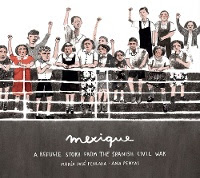author: María José Ferrada
illustrator: Ana Penyas
translator: Elisa Amado
Eerdman’s Books for Young Readers (2020)
grades 2-up (Spanish, Mexican)
During the Spanish Civil War (1936-1939), Generalísimo Francisco Franco led the fascist Nationalist forces—with the assistance of Nazi Germany and fascist Italy—in overthrowing the democratically elected Second Republic. From 1939-1975, his dictatorship—known as the “White Terror”—was marked by forced labor, concentration camps, assassinations and summary executions, leading to an estimated death toll of between 160,000-200,000. During this time, Franco’s deals with US corporations financed his war and the dictatorship that kept him in power.
Mexique: A Refugee Story from the Spanish Civil War (originally published by Alboroto Ediciones, Mexico, in 2018 as Mexique: El nombre del barco (Mexique: the name of the ship) is an illustrated photo album from that time, depicting for young children the horrors of what it is to be alone and lost and not knowing what lies ahead. The story is based on interviews with some of the children—now adults—part of a group of 456 refugees whose Spanish Republican families sent them to the safety of Morelia, Mexico, aboard the Mexique at the start of the Spanish Civil War. Their parents were seeking something that most children don’t think about: a life without fear. The art is derived from photographs of the “Children of Morelia” and the ship that brought them to Mexico. The story is dedicated:
To the Children of Morelia.
And to all those who are moving in search
of a life without fear.
Through the words of a frightened child, young readers will feel the fear of the unknown as the children try to sleep while a volunteer comforts them:
Some cry. Especially at night.
They say that they dream that the ground is crumbling.
The houses are crumbling, and their memories are blank.
Clara, Sonia, Eulalia, María wake us up.
They say it’s just a dream,
one that we all dream together.
Clara, Sonia, Eulalia, María, our sisters,
collect our tears in their handkerchiefs and in the morning
return them to the sea.
The story’s stark, sepia-toned illustrations—many offset with touches of peach and rusted red—complement the fears and uncertainty of the children on the Mexique and their parents, who will never see them again.
On the cover, a large group of children hang off the railings of the ship. Most look forward. With both hands on the railing, a young boy in a white shirt smiles directly at the reader. Many others have their fists in the air. Their expressions range from excitement to sadness to fear. One girl wears a bright red dress. Two boys hold hands. Young readers will see many of these same children, some identified from their clothing, portrayed in the book.
The final illustration shows 12 adults standing in a semicircle, looking out at the young readers. These people represent some of those who defeated the Spanish Republic and transformed it into the violent and terrifying world that the children have fled. They are soldiers, a nun and priest, spies, businessmen, fascists, and government officials. Sprawled at their feet are tiny figures of dead people: revolutionaries, bloodied and mutilated. They represent the parents, whom the children will never see again. And overhead soar two buzzards.
Mexique is a photo album of sorts. It is, as artist Ana Penyas (ana penyas libros) writes (in Spanish), “a story that recovers one of the first episodes of the Spanish exile, and at the same time, evokes the history of all the ships that cross the ocean every day, transporting human beings who have the right to a life without fear.”
Here is a mom giving a last hug to her baby. Here is a father embracing his young son for the last time. Here is another mom, handing her little girl over to a stranger as her eyes plead: We trust you with our life’s blood. And here is the stranger, walking up the ship’s ramp with the little girl, looking down at her mom for the last time.
Elisa Amado is an amazing storyteller and translator, and she pulls no punches here:
War is a very loud noise.
War is a huge hand that shakes you
and throws you onto a ship.
Of course, young children will not understand the violent roots of fascism, how easily it can take hold, and the destruction it leaves in its path. What they will understand, through text and illustrations, is, as the United Nations Universal Declaration of Human Rights (Article 3) states: “We all have the right to live in freedom and safety.”
*Highly recommended for all home, classroom and library collections.
—Beverly Slapin
(published 2/17/21)


No comments:
Post a Comment
We welcome all thoughtful comments. We will not accept racist, sexist, or otherwise mean-spirited posts. Thank you.